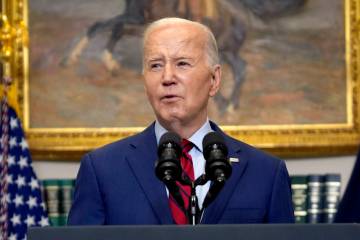VICTOR JOECKS: Details missing from new education funding bill
The long-awaited bill creating a new education funding formula is here. Many key details, however, are yet to be determined.
On Monday, Senate Education Committee chair Mo Denis, D-Las Vegas, released the blueprint for a new school funding plan, Senate Bill 543. For years, many Democratic politicians have criticized the current formula, called the Nevada Plan. They claim it’s old and outdated. Their biggest beef is that it doesn’t allocate more money for students who lack English proficiency or live in poverty. The theory is that it’s harder to educate those students, so they need additional services, which costs additional money.
Denis’s new Pupil-Centered Funding Plan would change this. Special education, ELL, low-income and gifted students would all receive more money because the base per-pupil allocation would be increased by a certain percentage for students in those categories. This is known as weighted funding.
The obvious question: How much extra money would each class of student receive?
The bill doesn’t say. Instead, it says lawmakers shall appropriate an “amount of money determined to be sufficient by the Legislature.” It also creates an unelected commission to review those amounts and make recommendations for future sessions.
Another big change is the creation of a single “statewide base per-pupil funding amount.” Currently, Nevada’s per-pupil guarantee is $5,967. Total per-pupil spending is $9,329. But that’s an average. Some Nevada counties receive much more than that. The Clark County School District, which includes around two-thirds of Nevada’s students, receives the lowest amount.
For instance, the Esmeralda County School District spent $33,263 per student during the most recent school year. The Clark County School District spent $9,146 per pupil. It looks as if Clark County is getting ripped off. That’s certainly the impression politicians have tried to leave when critiquing the Nevada Plan.
But there’s good reason for the disparity. There were 73 students in Esmeralda. Higher per-pupil costs are inevitable when a school district that’s almost three times the size of Rhode Island serves a few dozen students. The Nevada Plan sets a different guarantee for each county, because each county is different. If you give the Esmeralda and Clark County districts the same per-pupil amount, you wipe out education in Esmeralda.
The Pupil-Centered Funding Plan doesn’t ignore this completely. Instead, the bill directs the unelected commission to establish adjustment factors for cost of living, small schools and small districts. No one knows what those numbers will look like. The amounts could even end up similar to what school districts received under the Nevada Plan. The bill also says that lawmakers intend to ensure that school districts receive as much money as they did the year before.
In practice, this would likely mean rural school districts will receive flat funding — regardless of student growth and inflation — for years to come. New education funding would flow to Clark County.
You can criticize the Nevada Plan all you want. But at least it considers the entire state of Nevada and includes enough details to qualify as an actual plan.
Contact Victor Joecks at vjoecks@reviewjournal.com or 702-383-4698. Follow @victorjoecks on Twitter.





























